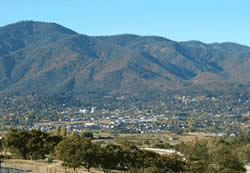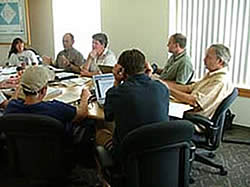Healthy Forests Success Story
Ashland Forest Resiliency Project
Rogue River-Siskiyou National Forest
Healthy Forests - Fuels Reduction
By Linda Duffy, District Ranger
July 1, 2009

View of Ashland, Oregon.
Project Description
The Rogue River-Siskiyou Ashland Forestry Resiliency Project represents a history of successful collaboration between the Forest Service and the City of Ashland, Oregon, which is located along a Wildland-Urban Interface. Southern Oregon’s Siskiyou Mountain Ranger District serves as a scenic backdrop to the community of Ashland, and it is highly valued for its recreational opportunities.
Due to one hundred years of fire exclusion, fuel accumulation and significantly overstocked dense conditions along the wildland-urban interface now present risk for large-scale, high severity wildland fires. Such an event could severely disrupt the supply of clean drinking water from the Ashland Municipal Watershed and impact old-growth ecosystems in the area and habitat for threatened species. The purpose of the Ashland Forest Resiliency Project is to protect values at risk, reduce hazardous fuels and red crown-fire potential, and to retain conditions more resilient to wildland fire and large-scale events.
Conversation and development of the project began as soon as the Healthy Forest Restoration Act (HFRA) was passed in 2003. The project fell under several provisions of HFRA, with its hazardous fuel buildup in a wildland-urban interface near an at-risk community and municipal watershed. A Community Wildfire Protection Plan was completed by the City of Ashland in September of 2004 in which a citizen alternative offered greater input regarding the Ashland Forest Resiliency Project. A Final Environmental Impact Statement has been released for the project and is ready for a decision notice to begin implementation.
Collaboration Success

Collaboration meeting.
While the Forest Service and the city of Ashland had a history of previous collaborative engagements, beginning with agreements to protect water quality in 1929, HFRA elevated the collaboration process. Collaborative partners included the City of Ashland, Klamath-Siskiyou Wildland Center, the Nature Conservancy, Oregon State University, industry, individual environmental activists, and a range of generally interested citizens and individuals. Collaborative efforts included:
- Government-to-Government consultation letters were mailed to the Confederated Tribes of Siletz Indians, Confederated Tribes of the Grand Ronde Community and the Quartz Valley Indian Tribe.
- Public meetings and briefings were held to understand and discuss treatment options and concerns.
- Field trips were taken to look at site conditions.
- Community members along with the help of volunteer professional forest and ecology scientists within the community developed an alternative, which was selected as the preferred alternative to the Forest Service Proposed Action for the Ashland Forest Resiliency Project. The Forest Service actively engaged in regular interaction with community members and the City of Ashland throughout the development and submission of the alternative.
Lessons Learned
- While the Forest Service and the city of Ashland had a history of collaborative engagements, HFRA elevated this engagement and the collaboration process.
- It is recognized that there is an ongoing need for collaboration. "One of the reasons we're working so hard on collaboration here is because [forest management is] generational work. We're trying to build a culture." Linda Duffy, Forest Service District Ranger
- The District Ranger played a critical role in working with the City of Ashland and responding to concerns through a number of discussions and community dialogue meetings.
- Efforts taken to build communication between Forest Service staff and community leaders has helped facilitate greater understanding of the HFRA process.
For More Information
- Ashland Forestry Resiliency Project Final Environmental Impact Statement
- Community Wildfire Protection Plans research funded by Joint Fire Science Program
- Community Wildfire Protection Plan Case Study, City of Ashland, Jackson County, Oregon
- Ashland Watershed Stewardship Alliance Case Study
Contact Rogue River-Siskiyou National Forest
Linda Duffy, Siskiyou Mountain Ranger District Ranger
541.552.2903
lduffy@fs.fed.us